The dwarves, or dwarva, as the dwarves refer to themselves,[1] are one of the major humanoid races of the Dragon Age setting. Strong, stocky, and shorter than any other humanoid race, the dwarves are skilled builders and boast a long tradition of courage and martial skill that has served them well in their millennia-long battle against the darkspawn. They are a race in decline, once developed a huge, great empire which spread across vast underground networks of twelve[2] great thaigs that spanned the breadth of Thedas. However their world was all but destroyed during the First Blight.
In addition to the loss of nearly all thaigs and the majority of the Deep Roads to darkspawn, dwarves are known to be increasingly infertile due to their proximity to the darkspawn taint,[3] a situation which has given rise to anxiety for the future of the race, as well as the invention of noble hunters to bolster the children born to noble houses.
Unlike elves and humans, dwarves do not naturally enter the Fade, as they do not dream[4] and lack magical ability. However, they are not completely barred and may enter it in exceptional circumstances. This is reflected in their resistance to magic, and accounts for their high tolerance to lyrium exposure.[5] Dwarves who live on the surface for a long time (or who were born there) appear to gradually lose this resistance - however, there is still no recorded exception to their inability to learn spellcasting.[6]
A unique dwarven ability is "Stone sense",[7] a talent for subterranean navigation derived from the race's progenitor, the Stone. However in the games, this talent is not implemented neither as a game mechanic nor as a plot device. The stone sense of dwarves as well as their magic resistance is slowly lost the longer they are on the surface.
Involvement
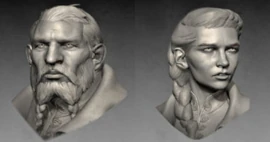
Concept art of dwarves in Dragon Age: Inquisition
In Dragon Age: Origins, dwarves are able to play two classes, warrior and rogue; a dwarven Warden can choose the Dwarf Noble or Dwarf Commoner Origins.
Racial benefits: +1 strength, +1 dexterity, +2 constitution, 10% chance to resist hostile magic
In Dragon Age: Inquisition, dwarves are a playable race for the Inquisitor.
Racial benefits: +25% Magic Defense
History
“Time, in the end, is one long Proving, and we are failing at the test.” ―Warrior Etrol of House Saelac[8]
Early years
The first dwarven kingdom was founded in a time beyond even the history kept by the Shaperate.[9] Beneath the Free Marches there are also ancient dwarven ruins which displayed cultural practices that are completely foreign to the dwarves, such as the construction of temples and the veneration of a pantheon of deities. Furthermore, within these ruins there are items which could only have been created by magic, yet there are no records of any dwarf being able to cast spells.[10]
At -4600 Ancient (-3405 TE) the elves of the great elven kingdom of Elvhenan are believed to first make contact with the dwarves, 1,500 years before the arrival of humans in Thedas.[11]
Golden Age
Before the first Blight, the dwarven empire expanded as much underground as the Tevinter Imperium did above. Dwarves in this time interacted freely with both the Tevinter Imperium and the elves. The dwarven rulers Endrin Stonehammer and Orseck Garal created the foundations of the dwarven empire, working in conjunction with the first Tevinter Archon, Darinius.[9] At -1200 Ancient (-5 TE) an alliance is forged between the dwarves and Tevinter Imperium[12] which still lasts up to the present day.
Eventually at -1170 Ancient (25 TE)[13] Garal moved his kingdom to Orzammar to preside more directly over the commercial aspects of dwarven life, mining and crafting, as Orzammar was the ancestral seat of the Miner and Smith castes.[14] and because of the turmoil in the Imperium following the death of the Archon Darinius.[15] Stonehammer took up leadership of Orzammar after Garal's passing, expanding and improving the city, and creating the Hall of Heroes and altering the Provings to allow for massive tournaments.[16] In this period of great flourishing and wealth, thaigs were built under every human kingdom, and the Deep Roads experienced great development as the dwarves' chief method of travel between their cities. Dwarven artisans and engineers pioneered new crafting methods and built many cherished monuments to dwarven history, such as Gundaar's House of Crystalline Waters,[17] a massive underground lake decorated with shining quartz stalactites reflecting colors no dwarf had ever seen.
The empire was encompassed by several kingdoms, the major of them being Kal-Sharok, Orzammar, Gundaar and Hormak. At least since the times of the First Blight, each kingdom had its own Assembly, which however maintained allegiance to the capital of the empire.[18]
First Blight and post years
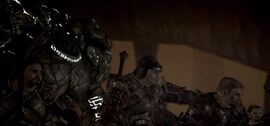
The fall of the dwarven empire
The First Blight is arguably the single most devastating event in the history of the race. The empire came to its knees as darkspawn flooded the Deep Roads that connected the countless thaigs and cities. Political disunity amongst the warrior and noble castes and the inability to focus on effectively stopping the darkspawn, resulted in the loss of countless thaigs over the next couple of centuries, and pushed them to the brink of extinction. Paragon Aeducan's resourcefulness played a major role[19] as well as the cooperation of the four major kingdoms which allowed them to survive. However, as most of the Deep Roads are sealed, communication lines faltered between the surviving kingdoms. Because of that, at -195 Ancient (1000 TE), each kingdom elected its own king while maintaining allegiance to the High King of Orzammar.[18]
At this time one of the dwarves' greatest engineering feats was developed; the creation of giant golems.[17] These creatures - bipedal warriors of stone or metal were the product of the Paragon Caridin. Caridin was already renowned as the architect of Bownammar in the Deep Roads, but the advent of golems superseded that. The constructs allowed the dwarves to push the darkspawn back and reclaim some of their lost territory. However, this progress ceased all too soon as Caridin disappeared, taking the secret of making golems with him. He is presumed dead and none has been able to replicate his breakthrough; the use of golems on a military scale has become but a memory.
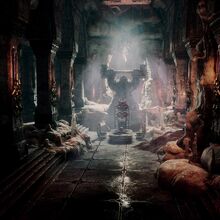
Ancient treasures left behind
Sealing the Deep Roads
However, the darkspawn continued pushing, and in an effort to save the race from complete annihilation, High King Threestone ordered the sealing of the Deep Roads leading to the remaining three kingdoms in -45 Ancient (1155 TE).[20] Within a decade the kingdoms of Gundaar and Hormak had fallen.[6] The last of the Roads are sealed in -15 Ancient (1180 TE) cutting off Kal-Sharok which is believed lost.[21] The kingdom of Orzammar had become the only bastion of dwarven culture in Thedas, the last outpost of the race.
The last millenium
Even though the sealing of the Deep Roads significantly decreased the pressure on Orzammar, the darkspawn were able to find ways to breach them. For the next centuries, the kingdom was in a steady decline by losing most of its outlying thaigs. Despite that, the strict traditions of Orzammar's culture as well as its alliance with Tevinter Imperium persisted.
In the Towers Age the Chasind Wilders along with other "terrible things" were led by Flemeth's daughters, the Witches of the Wild. This force invaded the region of what would be Ferelden and were all but unopposed until the hero Cormac led an army of Alamarri fighters and Orzammar dwarves. After a long series of dreadful battles, the Chasind were all but destroyed, and the witches burned. To this day the Fereldans eye the Korcari Wilds warily.[22]
During the Fourth Blight the dwarves of Orzammar assisted the Imperium in lifting the siege of Marnas Pell[23] however the Ortan Thaig was lost.[24]
Dragon Age
In 9:12 Dragon it is discovered that the kingdom of Kal-Sharok had in fact survived. However the relations between the two kingdoms are strained because Orzammar demands Kal-Sharok's allegiance and because it was abandoned by Orzammar a millennium ago. One year later, Bownammar is lost to the darkspawn.
In 9:30 Dragon, the dwarves of Orzammar assist Ferelden in defeating the Fifth Blight and one year later the Primeval Thaig was rediscovered beneath the Free Marches. Furthermore, the dwarven army led by House Helmi cleared the great thaig of Kal'Hirol and the Deep Roads connecting it to Orzammar from darkspawn, reclaiming it once again.
Culture
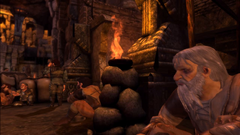
Casteless dwarves in Dust Town
The dwarven social hierarchy is ruled by complex, interrelated, and rigid castes. The casteless, commonly known as "dusters" after their ghetto of Dust Town, are the lowest rung of dwarven society: outcasts in their own city, unable to take up work among the higher castes, nor to defend their honor in the Provings or fight the darkspawn to protect the city, dwarves rejected by the Stone itself. Dwarves who are exiled or born on the surface are also officially casteless - but with an increase in the number of higher-caste dwarves choosing to live on the surface, it is becoming difficult for some surface dwarves to be considered permanent exiles. The average dwarf will never see the surface, and often will have superstitious beliefs concerning surface-life (such as falling into the sky, or the sun falling to the ground).[25]
Above the casteless are servants, miners, smiths, merchants, deshyrs and nobles. Nobles are the nobility of dwarven society, while the deshyrs are a group of dwarves who participate in the Assembly on behalf of their noble houses. While it is possible for some dwarves to better their family's station by performing great deeds and/or siring children with higher-caste dwarves, these remain rare and difficult circumstances. Lower-caste dwarves who rise in caste are generally considered "upjumped" by the highest castes. In dwarven society, children inherit the cast of their same-sex parent; should a son be born, he would inherit his father's caste, or castelessnes, should that be the case.
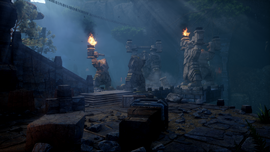
Ancient dwarven art
It should be mentioned that slavery existed in the times of the ancient dwarven empire.[26]
Monarchy is the dwarven standard of government, but heredity tends to be a weak factor in determining who sits on the throne when the time comes for a new ruler. While a king may propose his heir to the throne, the next ruler is ultimately determined in the Assembly by a vote of the deshyrs.
It has been mentioned that most of the wealth of the dwarves comes from selling processed lyrium to the mages of Thedas. The Chantry holds a monopoly on lyrium trade with the dwarves (in order to maintain control over templars and mages), but there remains a flourishing black market of the substance, dominated on the dwarven end by the carta in Dust Town.
Education
- Main article: Education
Education in Orzammar appears to be given to those with caste and may in part be administered by members of the Shaperate.[27] Among the casteless there is no formal education and most are functionally illiterate.[28]
Diet
- Main article: Dwarven diet
The diet of the dwarven race is unique to all other races in Thedas, owing to the majority of dwarves living their entire lives underground. The diet of those living in the thaig of Orzammar are the most documented, as opposed to the unknown diet of the more secretive dwarves of Kal-Sharok. As a result of living underground, a dwarf's diet relies heavily upon foodstuffs harvested, and animals found, in the Deep Roads.
Religion
Unlike many other cultures in Thedas, dwarves do not worship anthropomorphic gods. Instead, their philosophy promotes personal excellence and an almost intimate tie to the Stone that houses them. Referring reverentially to the Stone, the dwarves speak of it as being alive. They are the Stone's children: they respect her, they fear her, they cherish her, and they give thanks to her for protecting them and providing them with her bounty. According to Shaper Czibor, this religion has been practiced for two thousand years by the dwarves.[29]
Their other cultural beliefs are more akin to ancestor worship. Dwarves who lead a strong and noble life are said to strengthen the Stone when they die, becoming one of the Ancestors. Those who are ignoble or disgraced would weaken the Stone and are therefore rejected by it for all eternity.
Every once in a while, a dwarf is declared by the Assembly to be particularly noble. If the required motion is passed in the Assembly, these dwarves become Paragons and are revered during their lives as living Ancestors. When a non-Noble dwarf achieves Paragon status, a noble house bearing their name is established. The deeds of a Paragon are carefully recorded in the Memories, records of lineage and deeds that help determine what caste a dwarf is born into. The word of a Paragon is held in such esteem that you can surpass even the king's word. Furthermore, a dwarf can be declared as a Paragon even posthumously.[30]
Surface dwarves still preserve their beliefs in the Stone, while some do not follow or care for any religion. Only a small minority of them is part of the Chantry.
Gender and sexuality

A male dwarf and a casteless female
- Main article: Sexuality and marriage
In spite of the fundamental conservativeness of the dwarven culture, sexuality plays an important role, largely due to the low racial birth rate. It has been suggested that the root cause of the low birth rate may be "corruption-caused infertility" contracted from exposure to the Deep Roads.[3] As is common in surfacer society, nobles and other high-caste dwarves are expected to marry only within their caste.[31] Dwarves do not often mate with other races as such contact is limited in the isolated Orzammar. And as they naturally consider themselves superior to other races, and such mingling is looked down upon in any case.[32]
Female dwarves appear to have little control over their sexuality,[33] as their chiefest asset, regardless of caste, is their ability to bear children. Noble females are especially pressured to marry and bear children.[34] Male nobles are expected—even encouraged—to be promiscuous, in order to sire as many children as possible, often with noble hunters. Noble females must guard their virtue (or have it guarded by male relatives, as in the Dwarf Noble origin).[35]
Casteless females understand their value in Orzammar is solely in breeding among the castes, which gives them agency, in a fashion, as noble hunters, who seek the sexual attentions of noble males in order to advance themselves (and/or their families or 'sponsors'). Casteless males have a more difficult situation, as they can only hope to sire children with higher-caste women - most of whom are not in a position to pursue affairs with them, or who are not interested in doing so.[36]
Additionally, in terms of courtship, it is noted that for a dwarven male to wear both vambraces indicates he is unmarried and eligible.[37]
Shaperate
- Main article: Shaperate
The judicial functions of government are split between the king and the Shaperate. The king and his warriors deal with crime and maintain order, while the Shaperate deals with civil disputes. The Shaperate is also ultimately responsible for the preservation of all records current and historical. As a result, it is the supreme authority over the authenticity and binding nature of contracts, as well as legal precedent. The Shaper of Memories is considered a role of absolute impartiality in dwarven society, and commands enormous respect as a disinterested third-party in legal matters.
In dwarven society the role of the Shaper is one of great honor, privilege, and also hardship.[38] A Shaper must honor the Stone, protect it, and present a new history to the Memories. However, this means that a Shaper must seek out knowledge and history beyond the city and its inhabitants, venturing into the Deep Roads to record the history of lost thaigs and ruins and dwarves whom the Memories might otherwise forget. A Shaper must be prepared to risk all—perhaps even their own life—so that the dwarven race might reclaim its lost knowledge and learn from it.
Legion of the Dead
- Main article: Legion of the Dead
The Legion of the Dead is an independent branch of the dwarven army which answers directly to the Kings and Queens of Orzammar. It is considered to be the most intimidating and devastating dwarven military force and most attribute this to the fact that the Legionnaires consider themselves already dead.
Provings
- Main article: Provings
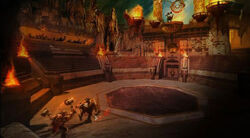
Proving concept art
The Provings are public arena battles fought for the sake of honor and glory and to entertain the masses. They take place in the Orzammar Proving arena. Dwarves believe that a fighter who wins a Proving has the approval of the Paragons and so they use Provings to settle debates and honor challenges that could not be settled otherwise. This usually falls to warrior caste champions. Some Proving matches are fought to the death, but even in a dwindling society such as Orzammar, that one death is thought preferable to the widespread bloodshed of a conflict between noble houses. In recent years, the Provings have also been used for entertainment and events to honor special guests, and each year the best fighters in Orzammar meet for the "Trials of Blood," a great tournament that crowns the kingdom's best and most popular fighter.
The great gladiatorial battles of the ancient Tevinter Imperium are based on this dwarven tradition.
The Warden has at least one opportunity to take part in a Proving - through either dwarven origin story and/or in the process of soliciting Orzammar's aid against the Blight.
Golems
- Main article: Golem
In ages past, the Paragon Caridin magically crafted huge stone and metal golems to act as war machines for the dwarven armies. The craft of making new golems was lost with Caridin himself, and the main body of war golems, known as the Legion of Steel, was lost in a futile search for him.
Settlements
The Memories tell us that our kingdom once reached far beneath the mountains, and that the thaigs were almost beyond counting.
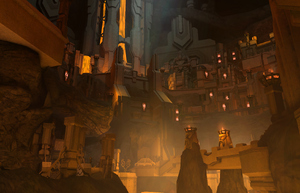
Orzammar
There are currently three remaining dwarven cities where once there were twelve great kingdoms adjoining the dwarven empire, in addition to few other smaller thaigs. Orzammar is the largest, greatest and proudest of the three. The other dwarven cities are Kal-Sharok and Kal'Hirol.
Kal-Sharok was thought to be lost to the darkspawn incursion after the First Blight, but in 9:12 of the Dragon Age the king of Orzammar learned of Kal-Sharok's survival, although it had done so only at great cost, and with a great deal of resentment against the dwarves of Orzammar who had sealed off the Deep Roads and given up Kal-Sharok for dead. Far from a joyous reunion, communication between the kingdoms has so far consisted of Orzammar's insistence that Kal Sharok pay homage to its king and Kal Sharok's response that they consider the denizens of Orzammar who gave them up for dead to be wraith-blooded traitors to the Stone. It is unknown what the future relationship of the two cities will be, if anything.[40]
The last is Kal'Hirol which was lost to the darkspawn and recently reclaimed by the dwarves of Orzammar.
Politics
- Main article: Assembly
Orzammar—as the ancient empire likely was before the division into city-states—is a constitutional monarchy, consisting of a king and one legislative house entirely of nobles (approximately eighty of them at the time of Dragon Age: Origins). Other castes are not represented in any fashion in the Assembly.[41] The noble houses which are allowed to have a deshyr and represented in the Assembly are those which can trace a general, deshyr or a Paragon among their ancestors.[42] Subsequently, lesser noble houses may not have a vote in the Assembly as well as the number of deshyrs in the Assembly can easily vary. The Assembly holds the power to advise the king, approve or veto acts of the king, propose policy, declare Paragons, and elect new kings. Furthermore, the Steward of the Assembly is a non-voting member.
- Main article: Dwarven royalty
When the king or queen die, the Assembly goes into deliberation until they choose the next monarch, by majority vote. It is traditional for the king or queen to nominate their successor, usually their eldest child, or less often, a younger child or even someone from another House. This decision carries a significant political weight during the election, however it is not enough to determine the new ruler. Fighting, blackmail, and assassination can be intense as contenders for the throne vie for power, and can last for a very long time before the succession is resolved. Dwarves, as they themselves note, are hardheaded and stubborn in their decision-making.
Typically a male is chosen as king, but on rare occasions a female is chosen as queen.[43]
The other crucial authority of the Assembly is to declare Paragons. Declaring a dwarf a Paragon is essentially declaring a new noble house, since that Paragon and their family will be elevated to noble status. From then on, they will have the right to their own deshyr in the Assembly. All other growth of the Noble caste depends solely on the fertility of its females. Because dwarven society (in particular the nobility) is essentially conservative, nominations for Paragon are extremely rare.
While the king may propose legislation, the Assembly has the authority to block the king's actions through dissent and deadlock, limiting the king's ability to affect domestic law or international relations. The king's primary functions are as an important figure in ceremony, and as the Commander-in-Chief. The king's greatest autonomy is in the deployment of troops in the Deep Roads and the training of warriors. It is unclear whether the king is also the de facto general of the dwarven army, though it is implied that each is a separately-held office and his role as Commander-in-Chief is mainly as a figurehead.[44]
Foreign relations
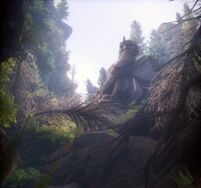
Traces of the dwarven empire's former greatness still remain on the surface world
One would be hard pressed to find a people prouder of their history and accomplishments than the dwarves of Orzammar. They have done much of great worth. Their architectural feats alone are staggering. But their greatest triumphs are also all long past, and their pride eclipses them. In fact, the dwarves' pride has contributed substantially, if not definitively, to Orzammar’s current condition. There is little doubt that their embattled kingdom could stand the military aid of any surface kingdom that would be willing to provide it.
The dwarves of Orzammar are not xenophobic, but neither do they believe that there is much of worth to be found beyond their stone halls. They believe dwarves to be the most formidable race of Thedas and condescend to outsiders on the unusual occasions when they interact. To their credit, most dwarves of Orzammar can be readily convinced that some particular human or elf is worthy of respect based on deeds either observed or reported, but at the same time, these dwarves also argue until the end of their breath that these individuals are unusual exceptions to the general rule.[40]
Grey Wardens
Grey Wardens and the dwarven people have always had a kinship through their shared battle against the darkspawn. Dwarves are consequently viewed as excellent recruits to the Order due to their experience against the darkspawn.[45] It is also known that dwarven Grey Wardens lifted the hundred day siege of Orzammar.[46] However, as there are fewer dwarves due to low birth rates, there are also fewer dwarven Wardens.[47] Grey Wardens are also the only surface organization to care about the endless war the dwarves wage against the darkspawn in the Deep Roads.[48]
When the time of a Grey Warden's Calling draws near, a Warden honors a longstanding agreement between the Wardens and the dwarves and serves a year fighting darkspawn in the Deep Roads at the side of the dwarves.[49] When the advance of the taint is unbearable, the Warden is celebrated by the dwarves and then enters the Deep Roads for their Calling. As noted by Alistair, the dwarves respect the Grey Wardens for their sacrifices.
Orlais
The dwarves of Orzammar maintain a good relationship with the Orlesian Empire with which they share borders in the western side of the Frostback Mountains. They provide the empire with lyrium and minerals, as well as smithing. Lyrium is especially important as it is used by Circle mages as a mana replenishment resource of their more complex spells and consumed by the Chantry's templars.[50]
Tevinter Imperium
The dwarven empire has been allied with the Tevinter Imperium for more than 2,000 years. Dwarven influence can still be seen in Imperial Proving Grounds and the use of three massive golems called
surface dwarves present at Empress Celene's peace negotiation ball
Juggernauts, to defend the capital of Minrathous. The lyrium trade is the primary reason for their close alliance, and the magic-centric Imperium is mainly dependent on Orzammar to meet its immense demand.[51] Except the trade alliance, it is also known that the dwarves helped Tevinter during the Fourth Blight by lifting the siege of Marnas Pell and they received many accolades of the ruling Archon.[23]
Many surface dwarves live in the Imperium, not considered citizens but rather foreign dignitaries, even if their houses have existed in the Imperium for ages.
The Tevinter Imperium hosts numerous dwarven embassies, since the days of Archon Darinius and his alliance with the founding fathers of the dwarven empire, Orseck Garal and Endrin Stonehammer. There are dwarven embassies in every major city, much like dwarven settlements in other countries in Thedas. However Tevinter dwarves have their own branch of government, unlike dwarves in other countries. This body is called the Ambassadoria, representatives elected by the dwarves to advise the Archon and the Magisterium.[51] The Ambassadoria is more of a lobbying group than a parliament.
Dwarven embassies in Minrathous, Neromenian, and Qarinus are entirely underground and are considered by dwarves to reside within the Stone, allowing those in the embassy to retain their caste. Some dwarves serving in Tevinter embassies never leave these underground fastnesses. No dwarves are known to be kept as slaves in the Imperium, presumably due to their fundamental importance to the Imperium in providing lyrium.
Despite this close alliance, there are two known cases in which some of the dwarves secretly breached this pact. The first was with providing safe harbor in Cad'halash for the ancient elves who were fleeing after the destruction of Arlathan. The dwarves of Kal-Sharok were informed of this so they attacked Cad'halash and killed everyone in order to hide all the evidence from the Imperium.[52] The second occasion was when Amaranthine was held by the Avvars. The Imperium at that time were trying to conquer Ferelden and the dwarves secretly traded with the Avvars beneath Amaranthine.[53]
Languages and phrases
- Main article: Dwarven languages and phrases
The dwarves had multiple languages that are no longer generally spoken, and only a few phrases remain in common usage. Now they speak the "common tongue", once invented in order to trade with each other and later introduced to other races.[54]
Notes
- According to dialogue between Oghren and Zevran Arainai, dwarves are 100 times less numerous than humans.[55]
- All the races in Thedas are said to live approximately the same length of natural life.[56]
- Owing to their hardy constitution, sickness is thought to be rare among the dwarven folk. But their proximity to the darkspawn and low fertility rate have caused the population of dwarves to fall steadily (except during the Blights) for nearly a thousand years.[6]
- Children between dwarves and humans are extremely rare because of the low fertility rate of dwarves in addition to the small chances of producing offspring with other races. Half-dwarves are shorter than humans but taller than dwarves. Furthermore, it is more often that such mating would happen with surface dwarves as such union would be heavily stigmatized in Orzammar.
Children between dwarves and elves are even more rare. Their offspring would be dwarven to all appearances.[57] - The dwarves have developed superior vision in the dark, due to their underground life.[3] This ability is also shared by the elves.[58]
- Prostitution exists in Orzammar, with the finest brothels being restricted to the highest caste dwarves, such as warrior caste.[59]
- Dwarves have developed their engineering to a level of technology that surpasses everyone.[18] They have mastered clockwork and limited steam power.[6] Dwarven clockwork, while uncommon, is notable, as time-telling in Thedas is inexact.[60]
- Besides the language, dwarves also introduced currency, trade and entertainment to humanity.[54][61]
- Some of the old dwarven families' buildings are Dragon's Créche. They are buildings designed to kill the intruders, usually because they store important items. Such constructs take decades to complete.[62]
Trivia
- Early in development it was planned that dwarves would speak with a German accent.[63] It was, however, scrapped and the dwarves speak with varying North American accents.
- No dwarves have been introduced that can be romanced by the player character.
- Female dwarves were notably absent in Dragon Age II.
- Dwarven culture takes inspiration from societies such as the Aztecs and Mayans.[64]
- Qunari may refer to all dwarves, or possibly just bothersome dwarves, as "short mouth".[65]
Gallery
See also
- Stone Halls of the Dwarves, a book written by Brother Genitivi about dwarves.
References
|
External links
| ||||||||||||||||||||||||


![Dwarves WoT.jpg (572 KB) Male dwarves[66]](https://static.wikia.nocookie.net/dragonage/images/7/77/Dwarves_WoT.jpg/revision/latest/scale-to-width-down/154?cb=20190711111649)


